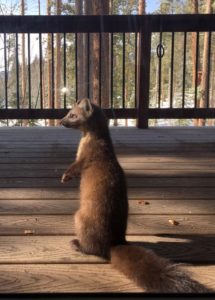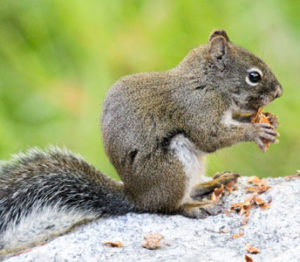
I come from a devout Catholic family, which means I have twenty-six first cousins on my mom’s side and almost as many on my dad’s. Given that, I consider myself a pretty good authority on how differently cousins can turn out. So when a friend in Columbine posted a picture of an American marten standing on his deck, I tried not to jump to conclusions about its disposition. The reason I say this is you may recall my previous articles about their weasel cousins, the otter and ermine. The highlights were that three otters tried to drown my neighbor’s Airedale terrier, which is how they kill their prey. And, ermine take over their latest meal’s burrow—and then decorates it with the unlucky animal’s fur and hide. Granted, they’re both adorable, but maybe not the kin you want to invite to Christmas dinner.
I’m happy to report that the American marten, also called a pine marten, doesn’t seem quite so . . . gruesome. They’re the only mustelid (family of 65 species of carnivorous mammals) that have semi-retractable claws. This enables them to lead an arboreal lifestyle in the trees as well as on the forest floor—they can even swim underwater. They often make their nests high in tree hollows or take over squirrel dens. They have fur on their soles to keep them warm, which creates a snowshoe effect that allows them to run atop the snow, and they burrow in the snow on chilly days.
As further proof of their versatility, they’re omnivores (they eat plants and meat). Their diet is based on voles (which only endears them to me more), snowshoe hares, small birds, fruits, conifer seeds, honey and even carrion if live prey is scarce. They’ll occasionally take a juvenile squirrel but they’re not as agile in the branches as adult squirrels and will usually leave them alone. And unlike the pine squirrel, pine martens help propagate forests since seeds pass through their gut intact. In fact, seeds have higher germination rates after, uhm, being processed compared to seeds that drop to the ground.
The American marten’s fur is shiny and luxuriant, resembling another of their many cousins, the sable. At the turn of the twentieth century, they were drastically depleted due to the fur trade. Their population has now stabilized and they’re not considered endangered, but deforestation due to us humans is always a threat. Like most states, it is legal in Colorado to capture them using live traps (only cage or box trap). Or, you can hunt them with a handheld bow, crossbow, handgun, rifle or shotgun – which given their cat-like size seems somewhat unproductive if you want to salvage any of their fur.
An article I read stated, “The marten is a rare animal that you’ll probably never see, save for paw prints in the snow.” Thanks to my quick acting friend for snapping this photo, which helps us all remember that you can’t judge someone’s character by what their family is like.
This article was originally published in The Boardwalk newspaper, Grand Lake, Colorado,

